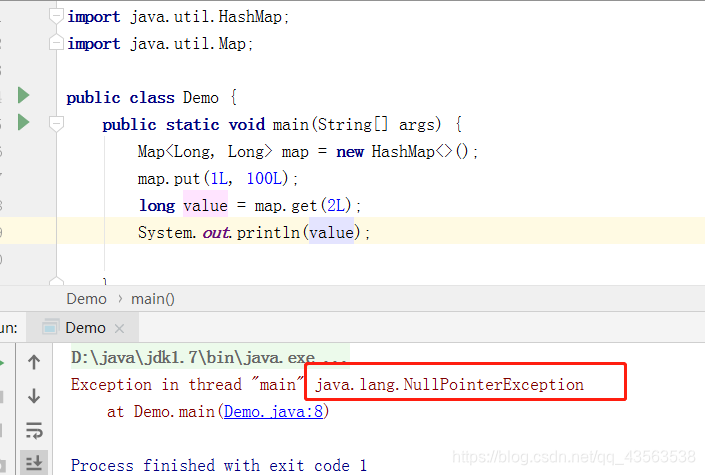public
class
Demo
{
public
static
void
main
(
String
[
]
args
)
{
Map
<
String
,
String
>
str
=
new
HashMap
<
>
(
)
;
String string
=
str
.
get
(
"a111"
)
;
System
.
out
.
println
(
string
)
;

在Map集合中,get一个不存在的值,不会抛出异常,获得的返回值为null。
但是,前几天开发时,碰到一个空指针异常。代码如下
import java.util.HashMap;
import java.util.Map;
public class Demo {
public static void main(String[] args) {
Map<Long, Long> map = new HashMap<>();
map.put(1L, 100L);
long value = map.get(2L);
System.out.println(value);

根据异常信息,是
long value = map.get(2L);
时抛出了空指针异常。分析过程如下。
1,自己首先想到的是map是否为空。因为map是new出来的,所以不可能为null。
2,然后自己又想到了难道从map中获取不存在的key时会报空指针异常?也不应该呀,如果key不存在,get会返回null,然后程序应该输出null才对。
后来,经过分析,发现这里面还有一个自动拆箱的过程。正是这个过程,才导致了空指针异常。
Map的value的类型是Long,它是long的包装类。map.get(2L),会返回null。正常来讲,Long value = map.get(2L);的写法时,value即可被赋值为null。但是,如上面的代码所示,value被定义成了long,而非Long,那么,就会将从map中得到的null进行自动拆箱,于是导致了空指针异常。
import java.util.HashMap;import java.util.Map;public class Demo { public static void main(String[] args) { Map<String, String> str = new HashMap<>(); String string =...
方法一: json格式定义
<!DOCTYPE html PUBLIC "-//W3C//DTD XHTML 1.0 Transitional//EN" "http://www.w3.org/TR/xhtml1/DTD/xhtml1-transitional.dtd">
<html xmlns="http://www.w3.org/1999/xhtml">
<meta http-equiv="Content-Type" content="text/html; charset=gb2312" />
<title>无标题文档<
public static void main(String[] args)
Map<String, String> a = new HashMap<String, String>();
String string = a.get("a111");
System.out.pri...
public static void main(String[] args)
Map<String, String> a = new Hash
Map<String, String>();
String string = a.get(“a111”);
System.out.println(string);
在
Map集合
中,get一个
不存在的值,不会抛出异常,获得的返回值为null。
public static void main(String[] args)
Map<String, String> a = new HashMap<String, String>();
String string = a.get("a111");
System.out.println(string);
}在Map集合中,get一个不存在的值,不会抛出异常,...
map.find(要找的值) //找到,返回
key;没找到,返回.end()
map.end() //最后一个元素的后一位 相当于空值吧
map.count(
key) // unoedered_
map 不允许使用count计数,
//如果有
key,返回1;没有
key,返回0
在 C++ 中,可以使用 `std::map` 容器来实现映射,获取指定 key 的 value 可以通过 `operator[]` 或者 `at` 方法来实现。
使用 `operator[]` 方法,代码如下:
```cpp
std::map<std::string, int> myMap;
myMap["key1"] = 1;
myMap["key2"] = 2;
int value = myMap["key2"]; // 获取 key2 对应的值,即 2
使用 `at` 方法,代码如下:
```cpp
std::map<std::string, int> myMap;
myMap["key1"] = 1;
myMap["key2"] = 2;
int value = myMap.at("key2"); // 获取 key2 对应的值,即 2
需要注意的是,如果 map 中不存在指定的 key,使用 `operator[]` 方法会自动插入一个对应的 key-value 对,而 `at` 方法会抛出一个 `std::out_of_range` 异常。因此,在使用时应根据实际需求选择合适的方法。

